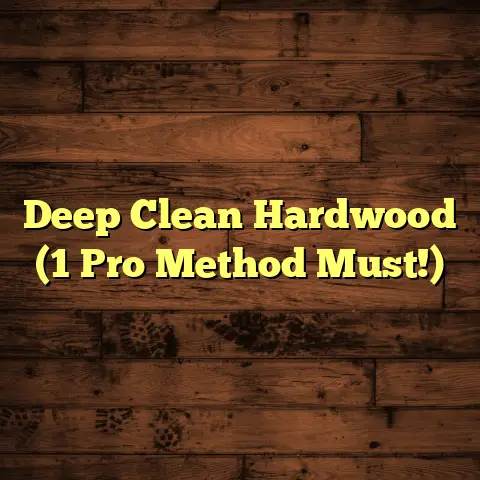Stop Concrete Floor Leaks Now! (5 Min Fix?)
Let’s talk about something that can really dampen the mood (pun intended!): concrete floor leaks.
Imagine this: you’ve invested in stunning, polished concrete floors. They’re the epitome of modern luxury, reflecting light and creating this amazing spacious feel.
You know, that sleek, minimalist vibe you see in magazines?
But then… uh oh. A dark patch. A musty smell. A creeping sense of dread. A leak!
Luxury isn’t just about fancy furniture, right? It’s about the foundation – literally! And leaking concrete?
That’s a fast track to not feeling luxurious. So, let’s dive in and see if we can tackle this problem head-on.
Section 1: Understanding Concrete Floors and Their Vulnerabilities
What Are Concrete Floors?
Okay, let’s start with the basics.
Concrete floors aren’t just for garages anymore! We’re seeing them everywhere – from chic apartments to trendy restaurants.
They’re made from a mixture of cement, water, and aggregates (like sand and gravel).
The mix is poured, leveled, and then cured. The curing process is critical!
It allows the concrete to harden properly and gain its strength.
Why are they so popular?
Well, they’re durable, versatile, and can be polished, stained, or sealed to create a ton of different looks.
Plus, they’re relatively low maintenance, which is a huge win in my book.
The Nature of Concrete and Its Porosity
Here’s the thing: concrete is strong, but it’s not invincible. It’s naturally porous.
Think of it like a sponge. It has tiny little holes that can absorb moisture.
Now, high-quality concrete, properly sealed, is much less porous. But over time, or with poor installation, that porosity can become a problem.
Water can seep in from below (groundwater), from the sides (hydrostatic pressure), or even from above (spills that aren’t cleaned up quickly).
And once water gets in, it can cause all sorts of trouble.
Common Causes of Concrete Floor Leaks
So, what’s actually causing that leak you’re staring at? Here are some of the usual suspects:
-
Groundwater Seepage: This is a big one, especially if you’re dealing with a basement floor. The water table can rise, pushing moisture up through the concrete.
-
Plumbing Issues: A hidden pipe leak under the slab is a nightmare scenario. It can be tough to find, but it’ll definitely cause dampness and potentially structural damage.
-
Cracks and Deterioration Over Time: Even the best concrete can develop cracks over time, especially with temperature changes or ground movement. These cracks are like open invitations for water to get in.
-
Improper Sealing or Curing of the Concrete: This is where proper installation is key. If the concrete wasn’t sealed properly, or if the curing process was rushed, it’s going to be more vulnerable to moisture.
I’ve seen so many jobs where a seemingly small crack in a concrete floor led to significant water damage underneath, simply because the initial sealing was inadequate.
It pays to get it right from the start!
Section 2: Identifying the Signs of Concrete Floor Leaks
Okay, so you suspect you might have a leak. What are the telltale signs?
Visual Indicators
-
Discoloration: This is often the first thing you’ll notice. The concrete might look darker in certain areas, or you might see a yellowish or brownish stain.
-
Efflorescence: This is a white, powdery substance that appears on the surface of the concrete. It’s caused by mineral salts being dissolved by water and then deposited on the surface as the water evaporates.
It’s a clear sign that moisture is coming through the concrete.
-
Damp Patches: Obvious, right? But sometimes they’re subtle. Feel the floor. Does it feel cooler or damp in certain spots?
Tactile and Auditory Signs
-
The Coolness Test: Like I said, damp areas will often feel cooler to the touch. Compare different areas of the floor.
-
Listen Carefully: If you suspect a plumbing leak, put your ear to the floor (yes, really!). Can you hear any dripping or trickling sounds? It might be faint, but it could be a clue.
The Importance of Early Detection
Look, I can’t stress this enough: early detection is everything.
A small leak might seem like a minor inconvenience, but it can quickly turn into a major problem.
Water damage can weaken the concrete, leading to structural issues.
It can also create a breeding ground for mold and mildew, which is not only unhealthy but can also damage your belongings.
Plus, the longer you wait, the more expensive the repairs will be. Trust me on this one!
I remember one client who ignored a small damp patch in their basement for months. By the time they called me, the entire floor was saturated, and they had a serious mold problem.
The cost of the repairs was astronomical.
Don’t let that be you!
Section 3: The 5-Minute Fix for Concrete Floor Leaks
Alright, let’s get to the good stuff.
Can you really fix a concrete floor leak in 5 minutes? Well, sometimes!
For very minor leaks, or as a temporary measure while you figure out a long-term solution, here are a few quick fixes you can try.
Important Note: These are temporary solutions. They’re not going to solve the underlying problem, but they can buy you some time and prevent further damage.
Immediate Solutions for Homeowners
Okay, so you’ve got a small damp patch. Here’s what you can do right now:
-
Dry it Up: The first thing you want to do is remove any standing water. Use towels, a mop, or even a wet/dry vacuum to soak up as much moisture as possible.
-
Improve Ventilation: Open windows and doors to increase airflow. This will help the area dry out more quickly. You can also use a fan to circulate the air.
-
Apply a Temporary Sealant (Optional): If you can identify a small crack or hole that’s the source of the leak, you can try applying a temporary sealant.
I’m talking about something like a quick-drying caulk or even a piece of duct tape (yes, duct tape!).
This isn’t a permanent fix, but it can help to slow down the leak until you can get a better solution in place.
Materials Needed for Quick Repairs
For these quick fixes, you’ll need:
- Towels or a mop
- Wet/dry vacuum (optional)
- Fan
- Quick-drying caulk or sealant (optional)
- Duct tape (optional)
- Cleaning supplies (mild detergent, water)
Step-by-Step Guide to the Fix
Okay, let’s walk through the process:
-
Preparation:
- Clean the affected area with a mild detergent and water. Remove any dirt, debris, or efflorescence.
- Dry the area thoroughly. Use towels or a fan to speed up the drying process.
-
Application (if using a sealant):
- If you’ve identified a crack or hole, apply the sealant according to the manufacturer’s instructions.
- Make sure the area is completely dry before applying the sealant.
- Apply a thin, even layer of sealant over the crack or hole.
- Allow the sealant to dry completely.
-
Curing Time and What to Expect Afterward:
- The curing time will vary depending on the type of sealant you use. Check the manufacturer’s instructions for specific curing times.
- After the sealant has cured, check the area for any signs of leakage. If the leak is still present, you’ll need to consider more permanent solutions.
Remember: This is a temporary fix! It’s not going to solve the underlying problem.
Think of it as a band-aid, not a cure.
Section 4: Long-Term Solutions Beyond the Quick Fix
Okay, so you’ve tried the 5-minute fix, but the leak is still there (or you know it’s going to come back). What now?
It’s time to think about long-term solutions.
Preventive Measures
The best way to deal with concrete floor leaks is to prevent them from happening in the first place. Here are some key preventive measures:
-
Proper Installation Techniques: This is crucial. Make sure your concrete floor is installed by a qualified professional who understands proper sealing and curing techniques.
I’ve seen so many problems that could have been avoided with proper installation.
-
Regular Maintenance: Clean your concrete floor regularly with a mild detergent and water. Avoid harsh chemicals or abrasive cleaners, which can damage the sealant.
-
Choosing the Right Sealing Products: There are a variety of sealing products available for concrete floors. Choose a product that’s specifically designed for your type of concrete and the conditions it will be exposed to.
For example, if you’re dealing with a basement floor, you’ll want a sealant that’s designed to resist moisture from below.
I personally like epoxy-based sealants for their durability and water resistance. Acrylic sealants are another good option, especially for decorative concrete floors.
When to Call a Professional
Sometimes, a leak is just too big or too complex to handle on your own. Here are some signs that it’s time to call in the pros:
-
Large or Persistent Leaks: If the leak is large or doesn’t go away after trying the quick fixes, it’s time to call a professional.
-
Signs of Structural Damage: If you see cracks in the concrete, or if the floor feels soft or spongy, it’s a sign of structural damage that needs to be addressed by a professional.
-
Suspected Plumbing Leaks: If you suspect a plumbing leak under the slab, call a plumber immediately. They have the tools and expertise to locate and repair the leak.
-
Mold or Mildew Growth: If you see mold or mildew growing on the floor, it’s important to have it removed by a professional. Mold can be hazardous to your health, and it can also damage your home.
The Benefits of Hiring Experts
I know it can be tempting to try to DIY everything, but when it comes to concrete floor leaks, there are some real benefits to hiring a professional:
-
Expertise: Professionals have the knowledge and experience to properly diagnose the problem and recommend the best solution.
-
Tools and Equipment: Professionals have access to specialized tools and equipment that can make the job easier and more effective.
-
Peace of Mind: Knowing that the job is being done right by a qualified professional can give you peace of mind.
I had a client once who tried to fix a leak in their basement floor themselves. They ended up making the problem worse, and they had to call me in to clean up the mess.
In the end, they spent more money than they would have if they had just called me in the first place.
Conclusion: The Path to Luxury Without Compromise
So, there you have it!
Concrete floor leaks can be a real pain, but they don’t have to ruin your dream of a luxurious home.
With quick fixes, preventive measures, and the help of a professional when needed, you can enjoy beautiful, leak-free concrete floors that enhance your living space for years to come.
Remember, luxury isn’t just about the things you own; it’s about the feeling of comfort and security in your home. And that starts with a solid, dry foundation.





